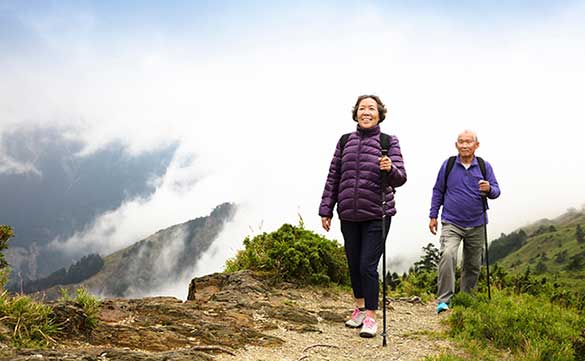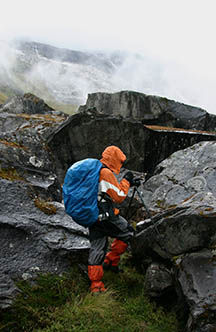
For many people, the trailhead is a symbol of a fresh start and a call to adventure. One of the greatest elements of a day on the trails is the sense of unknown, the realization that you never know what is going to be around that next bend. Will it be a gorgeous vista from along the ridgeline, another group of hikers sharing in your appreciation of nature or a switchback leading to yet another incline?
There’s an old axiom that the best way to get in shape for hiking is to get out there and do it. However, Todd Galati, M.A., ACE Senior Director Science & Research, points out that there is a big difference between practicing your sport and training to get better at it. When training or coaching clients who are interested in improving their ability to thrive on the trails, it is important to realize that hiking can be found along the endurance athletic spectrum, particularly if your clients will be hiking greater distances.
As with any training program, it is essential to know your client’s current state of fitness and in which type of activity he or she is planning to participate. Obviously, hiking the full length of the Appalachian Trail from Maine to Georgia requires a different training focus than completing a 5- or 6-mile loop each weekend with some friends.
Encourage your clients to think of their current fitness level as the trailhead on the journey to better fitness. They should pause and appreciate where they currently stand and think about what it’s going to take to get to their eventual destination. The rolling hills of the Midwest offer different challenges than the 6,000-plus feet of elevation gain experienced hiking the switchbacks of Mt. Whitney. The point, though, is that being better prepared for whatever lies ahead allows your clients to enjoy the experience rather than focusing on their straining breath or aching muscles as they struggle up, or down, a steep incline.
The Basics
There are two elements of hiking that should inform every training decision: distance and terrain. You should prepare—or overprepare—your clients for the distance they will be hiking, as this defines the duration of the physical activity. If you live in an area where clients will be hiking on relatively flat ground or gently rolling hills, endurance training should be combined with at least a small amount of strength training. If clients will be tackling more significant inclines and declines, resistance training becomes more important. Multiday, long-distance hikes also require higher levels of strength, in part because the longer the hike, the heavier the pack being carried (see sidebar).
Sarah Chandler, an ACE Certified Medical Exercise Specialist and Personal Trainer based in Asheville, N.C., points out that clients should be realistic about their fitness levels and goals. Many clients will want to just get out on the trails without any regard for proper progression, setting themselves up for potential injury. Instead, you should create a slow, gradual increase in the intensity, duration and frequency of the workouts and hikes being performed.
Cardiorespiratory Training
Adhering to the specificity training principle is key for hikers. Actually training on the trails—focusing on strength and anaerobic power by performing short, steep climbs on shorter training days and training for distance when time allows—is an ideal form of cardiorespiratory training. Both steepness and distance should increase over time as the client’s fitness improves.
If training takes place in a fitness facility, some creativity is needed to mimic conditions on the trail. A StepMill is an excellent tool, as it simulates actual stepping and the lifting of one’s body weight more effectively than other cardiorespiratory equipment. An elliptical trainer is a good choice as a form of cross training for low-impact days. As the trainer or coach, it is your responsibility to remind clients of the importance of varying their workouts and giving themselves time to recover.
If you are able to get outside with a client, but not necessarily out into the wilderness, climbing stairs is an excellent training option. Have clients walk the stairs at a local high school or college stadium. There is no need to run the stairs, as hikers do not typically incorporate speed into their outings.
In addition to cross training, consider adding interval training to clients’ regimens. Most hiking trails—particularly those in mountain settings—will naturally lend themselves to this type of workout. A typical hike might switch among steep inclines, long sections where the ground is relatively flat, gradual declines, and on and on.
Strength, Mobility and Flexibility
Note that while the following sections contain links to various exercises, you should visit the ACE Exercise Library to find more options when creating programs for your clients.
Hiking requires strength from head to toe, or perhaps more appropriately, from the feet to the neck, as the ground reaction forces experienced on the trail travel up the kinetic chain. In addition, adequate mobility and stability in the ankles, knees and hips are essential for safe locomotion on varied terrain and uneven trails. Galati, who holds all four ACE certifications, reminds us that adequate ankle mobility helps protect the knees, while hip mobility helps protect both the knees and lower back.
Lower Limb
Leg injuries often stem from the downhill portion of a hike, explains Galati. Downhill walking requires repeated eccentric contractions to slow progress against gravity and often produces more soreness and stress on the soft tissues. Many clients will focus on concentric muscle actions when exercising, so be sure to incorporate movements that work eccentric muscle actions as well so that your client is strong enough for the descent. The downward/lowering phase of squats, lunges and step-ups (all covered below) involve eccentric actions, especially when an additional load is used such as arm drivers, dumbbells or a step.
To strengthen the feet, Chandler suggests placing a towel on the floor and then gathering it with the toes. To increase mobility of the ankles, have clients sit or stand with one foot off the floor. They can then use that foot to write the alphabet as big as they can with their toes.
Strengthening the quadriceps and hamstrings is key. In addition, focus on hamstrings flexibility, which is necessary to counteract the effects of sitting and prevent the onset of lower-back problems. Tight hamstrings also limit hip mobility, which is discussed in more detail below. Chandler points out that stretching the iliotibial (IT) band is also important for movements that take place in the sagittal plane, such as hiking or cycling.
Traditional body-weight exercises such as lunges and squats are excellent choices. “When performing squats,” advises Chandler, “clients should start shallow and increase depth as their strength and technique improve. You can then progress by introducing single-leg squats and other variations.”
Once the client can properly perform squats as well as both backward and forward lunges, you can progress to step-ups, which Galati and Chandler agree are a great training option for these clients. Begin by using a single aerobic step and then slowly increase the height as the client progresses.

Thru-hiking, or Multiday Hiking, Requires Some Training Modifications
All of the training tips in this article are complicated by the potential addition of various pieces of gear. Hiking a few miles with a water bottle in hand and an energy bar in your pocket does not create the need for any training modifications, but heavy packs certainly complicate things. As anyone who saw Reese Witherspoon in the movie Wild knows, choosing what goes in your pack for a long trek is a matter of prioritizing and strategy, but that is well beyond the scope of this article. What concerns us is the weight of the pack, which can be substantial.
If you have clients training for a thru-hike, which can mean anything from a few days to a few months, it’s essential that you gradually add external weight to their workouts, either in the form of the actual pack that will be worn (adding weight as strength and endurance improve) or as a progressively heavier weighted vest. Building the postural strength to maintain good form while wearing the backpack is essential to injury-free thru-hiking.
Galati suggests that clients take the time to get used their gear before heading out on the trails. Encourage clients to pack their gear in different ways to figure out what works best. Of course, experimenting with different types of hiking boots, socks and other clothing is important as well.
Training for thru-hiking can be difficult, as performing long-duration hikes that combine cardiorespiratory exercise with strength and power day after day is tough to recreate in a training program. Recovery time is very limited in this scenario, so teach your clients to stay within their limits and see how their body responds. In addition, encourage them to enjoy what they’re doing and savor the experience.
One final note on protecting the knees: Chandler suggests advising clients to purchase hiking poles, as they can take the stress off the knees, particularly on downhills.
The Hips, Glutes and Hip Flexors
Both Galati and Chandler agree that hip mobility is perhaps the most important element of a training program for hiking enthusiasts. “The steeper the incline,” says Galati, “the more you’re flexing your hips before pushing off to take your next step. And the steeper the decline, the more you’re reaching down, extending the hips with each stride.” Hip flexor mobility protects the lower back from discomfort or injury, in addition to protecting the knees and back.
“You want to be both flexible and strong in this area of the body,” says Chandler, by strengthening the glutes (for example, by performing lunges, squats or step-ups) and stretching the hip flexors.
The Core and Upper Back
The core musculature includes both the lower back and the abdominal region. Strengthening the muscles of the core and upper back is important for hikers. You will often see hikers hinging their hips and hunched over during uphill climbs. This position, however, cannot be maintained for very long without strain or injury to the back or neck. Having the core strength to maintain good posture throughout a hike is essential.
The Day of the Hike
Sarah Chandler offers the following tips that you can share with your clients for maximizing their experiences when heading out for a single-day hike:
- Eat something healthy in the morning, and be sure it’s something you know your body handles well. Never hike on an empty stomach.
- Know the weather and dress appropriately.
- Stay hydrated on the trails. Be sure to carry water and snacks.
- Take breaks as needed.
- Start the hike slowly and gradually increase your speed after you are warmed up.
- Stretch after you’re warmed up. Chandler likes to stop about 10 or 15 minutes into a hike and do some simples stretches right there on the trail. She focuses on the calves, hamstrings, quadriceps, lower back and IT band.
- Find a balance between focusing on technique and posture and being mindful of the experience.
In Conclusion
As Sarah Chandler points out, hiking incorporates cardiorespiratory fitness, flexibility, muscular strength and muscular endurance. For this reason, the list of potential exercises and workouts is seemingly endless. In addition, Chandler suggests that hikers focus on posture throughout their day, as no amount of training can overcome chronically bad habits. She also states that strengthening the lats, triceps and posterior deltoids will help clients use hiking poles more effectively, thereby reducing the stress on the lower body.
Todd Galati recommends that hikers incorporate movement training into their routines, as maintaining stability throughout the body on uneven terrain is a key element of avoiding injury on the trails. He advises performing pushing and pulling movements with the upper body, single-leg movements performed in different directions, and balance and rotational exercises.
Clearly, hiking is far more than just a walk in the woods. If your clients want to enjoy nature safely and efficiently, it would be wise to train for hikes like the endurance events they really are. The energy, happiness and stress relief that can be drawn from a day on the trails is an important aspect of overall health and well-being, so preparing clients to hike safely and injury-free can be extremely rewarding.





 by
by 



